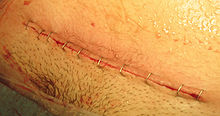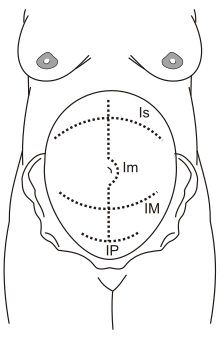
Caesarean section, also known as C-section or caesarean delivery, is the surgical procedure by which one or more babies are delivered through an incision in the mother's abdomen. It is often performed because vaginal delivery would put the mother or fetus at risk. Reasons for the operation include obstructed labor, twin pregnancy, high blood pressure in the mother, breech birth, shoulder presentation, and problems with the placenta or umbilical cord. A caesarean delivery may be performed based upon the shape of the mother's pelvis or history of a previous C-section. A trial of vaginal birth after C-section may be possible. The World Health Organization recommends that caesarean section be performed only when medically necessary.
A laparotomy is a surgical procedure involving a surgical incision through the abdominal wall to gain access into the abdominal cavity. It is also known as a celiotomy.

Hysterectomy is the surgical removal of the uterus and cervix. Supracervical hysterectomy refers to removal of the uterus while the cervix is spared. These procedures may also involve removal of the ovaries (oophorectomy), fallopian tubes (salpingectomy), and other surrounding structures. The term “partial” or “total” hysterectomy are lay-terms that incorrectly describe the addition or omission of oophorectomy at the time of hysterectomy. These procedures are usually performed by a gynecologist. Removal of the uterus renders the patient unable to bear children and has surgical risks as well as long-term effects, so the surgery is normally recommended only when other treatment options are not available or have failed. It is the second most commonly performed gynecological surgical procedure, after cesarean section, in the United States. Nearly 68 percent were performed for conditions such as endometriosis, irregular bleeding, and uterine fibroids. It is expected that the frequency of hysterectomies for non-malignant indications will continue to fall given the development of alternative treatment options.
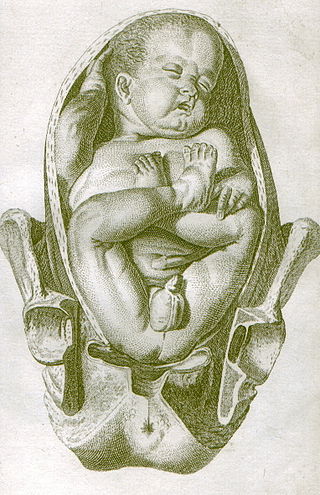
A breech birth is when a baby is born bottom first instead of head first, as is normal. Around 3–5% of pregnant women at term have a breech baby. Due to their higher than average rate of possible complications for the baby, breech births are generally considered higher risk. Breech births also occur in many other mammals such as dogs and horses, see veterinary obstetrics.
A hysterotomy is an incision made in the uterus. This surgical incision is used in several medical procedures, including during termination of pregnancy in the second trimester and delivering the fetus during caesarean section. It is also used to gain access and perform surgery on a fetus during pregnancy to correct birth defects, and it is an option to achieve resuscitation if cardiac arrest occurs during pregnancy and it is necessary to remove the fetus from the uterus.

Uterine rupture is when the muscular wall of the uterus tears during pregnancy or childbirth. Symptoms, while classically including increased pain, vaginal bleeding, or a change in contractions, are not always present. Disability or death of the mother or baby may result.

Myomectomy, sometimes also called fibroidectomy, refers to the surgical removal of uterine leiomyomas, also known as fibroids. In contrast to a hysterectomy, the uterus remains preserved and the woman retains her reproductive potential. It still may impact hormonal regulation and the menstrual cycle.
A self-performed caesarean section is a form of self-surgery where a woman attempts to perform a caesarean section on herself. Cases of self-inflicted caesarean section have been reported since the 18th and 19th century. While mostly deadly to either the woman, the child, or both, there are at least five known documented successful cases.

Placenta accreta occurs when all or part of the placenta attaches abnormally to the myometrium. Three grades of abnormal placental attachment are defined according to the depth of attachment and invasion into the muscular layers of the uterus:
- Accreta – chorionic villi attached to the myometrium, rather than being restricted within the decidua basalis.
- Increta – chorionic villi invaded into the myometrium.
- Percreta – chorionic villi invaded through the perimetrium.
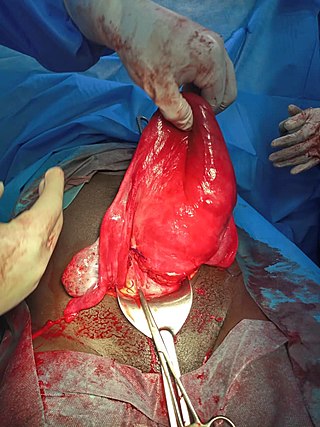
Uterine atony is the failure of the uterus to contract adequately following delivery. Contraction of the uterine muscles during labor compresses the blood vessels and slows flow, which helps prevent hemorrhage and facilitates coagulation. Therefore, a lack of uterine muscle contraction can lead to an acute hemorrhage, as the vasculature is not being sufficiently compressed. Uterine atony is the most common cause of postpartum hemorrhage, which is an emergency and potential cause of fatality. Across the globe, postpartum hemorrhage is among the top five causes of maternal death. Recognition of the warning signs of uterine atony in the setting of extensive postpartum bleeding should initiate interventions aimed at regaining stable uterine contraction.
In case of a previous caesarean section a subsequent pregnancy can be planned beforehand to be delivered by either of the following two main methods:

Max Saenger was a German obstetrician and gynecologist who was a native of Bayreuth.
Tubal reversal, also called tubal sterilization reversal, tubal ligation reversal, or microsurgical tubal reanastomosis, is a surgical procedure that can restore fertility to women after a tubal ligation. By rejoining the separated segments of the fallopian tube, tubal reversal can give women the chance to become pregnant again. In some cases, however, the separated segments cannot actually be reattached to each other. In some cases the remaining segment of tube needs to be re-implanted into the uterus. In other cases, when the end of the tube has been removed, a procedure called a neofimbrioplasty must be performed to recreate a functional end of the tube which can then act like the missing fimbria and retrieve the egg that has been released during ovulation.

A Pfannenstiel incision, Kerr incision, Pfannenstiel-Kerr incision or pubic incision is a type of abdominal surgical incision that allows access to the abdomen. It is used for gynecologic and orthopedics surgeries, and it is the most common method for performing Caesarian sections today. This incision is also used in Stoppa approach for orthopedics surgeries to treat pelvic fractures.
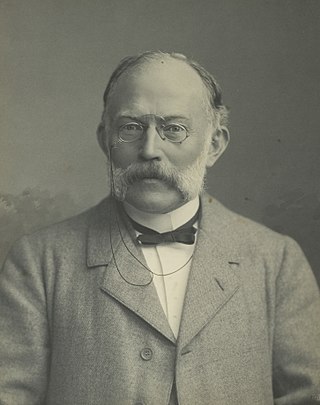
Ferdinand Adolf Kehrer was a German gynecologist who was a native of Guntersblum in Rhenish Hesse. He was the father of neurologist Ferdinand Adalbert Kehrer (1883–1966).

A shoulder presentation is a malpresentation at childbirth where the baby is in a transverse lie, thus the leading part is an arm, a shoulder, or the trunk. While a baby can be delivered vaginally when either the head or the feet/buttocks are the leading part, it usually cannot be expected to be delivered successfully with a shoulder presentation unless a cesarean section (C/S) is performed.
In surgery, a surgical incision is a cut made through the skin and soft tissue to facilitate an operation or procedure. Often, multiple incisions are possible for an operation. In general, a surgical incision is made as small and unobtrusive as possible to facilitate safe and timely operating conditions.
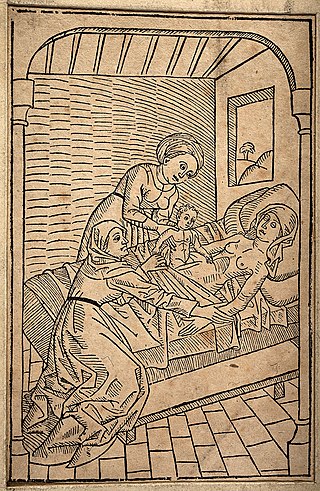
A resuscitative hysterotomy, also referred to as a perimortem Caesarean section (PMCS) or perimortem Caesarean delivery (PMCD), is a hysterotomy performed to resuscitate a woman in middle to late pregnancy who has entered cardiac arrest. Combined with a laparotomy, the procedure results in a Caesarean section that removes the fetus, thereby abolishing the aortocaval compression caused by the pregnant uterus. This improves the mother's chances of return of spontaneous circulation, and may potentially also deliver a viable neonate. The procedure may be performed by obstetricians, emergency physicians or surgeons depending on the situation.
Joel-Cohen incision is a skin incision used for Caesarean section. It is a straight incision that is 3 cm below the line joining both anterior superior iliac spines. It is similar to the Pfannenstiel incision, another commonly used incision in obstetric surgery. The Joel-Cohen cesarean section technique relies more heavily on blunt dissection than the traditional Pfannenstiel technique. Joel-Cohen technique has lower rates of fever, hospital stay, post-operative pain and blood loss compared to Pfannenstiel. The operating time and use of analgesia are also reduced. Additionally, the time needed to get out of bed, walk without support and time for re-appearance of audible intestinal sounds were shorter in Joel-Cohen group than the Pfannenstiel group in a study conducted with 153 women. In the two studies that compared the Joel-Cohen incision with the Pfannenstiel incision, the Joel-Cohen incision was associated with a 65% reduction in postoperative febrile morbidity.

Vesicouterine fistula refers to an abnormal communication between the bladder and uterus. The first case of vesicouterine fistula was reported in 1908. It was however first described in 1957 by Abdel Fattah Youssef, an obstetrician and gynaecologist in Kasr el-Aini hospital, Cairo, Egypt. It is characterized by a vesicouterine fistula above the level of the internal os, absence of menstrual bleeding, cyclical presence of blood in urine and absence of urinary incontinence with a patent cervical canal following a lower segment caesarean section. Six of such cases had been reported by other clinicians before the term Menouria was coined by Youssef.

